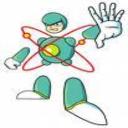PHYS1001 Lecture Notes - Lecture 5: James Prescott Joule, Kinetic Energy

Lecture 5
• James Joule- first person to acknowledge energy
• Conservation of Energy- Energy is not created nor destroyed
• Conservation of energy can be written as ∆E system + ∆Surroundings = 0
• Work- for a constant force “Work is defined as: the component of force applied over a
displacement x the magnitude of the displacement
◦ E.g. in people: food —> glucose —> heat —> voltage —> muscle contraction
—> mechanical energy
◦ W= F∆rcosine(theta)
▪ F.r
◦ It is sometimes called the scalar product
◦ If a ball rolls down a hill it has the same speed as when a ball falls of a cliff
• Kinetic energy:
◦ the Energy of Motion
◦ Change in kinetic energy is equal to work done
◦ KINETIC ENERGY SLIDE
• K=1/2mv^2
• Potential energy:
◦ An energy due to the interaction of two or more objects
◦ A single object cannot have potential energy
◦ E.g. a compressed spring ‘stores’ energy due to the interaction of atoms via
chemical bonds
◦ ∆U = -W (u is potential energy)
• GRAVITATIONAL POTENTIAL ENERGY
◦ h=v^2/2g
◦ U=-Gm1m2
r
• Power
◦ The rate of conversion of energy in time (the rate that we consume energy)
◦ Power is not energy- it measures how much energy is changed or used in a
given time
◦ P= W/∆t
find more resources at oneclass.com
find more resources at oneclass.com
Document Summary
E. g. in people: food > glucose > heat > voltage > muscle contraction. If a ball rolls down a hill it has the same speed as when a ball falls of a cliff the energy of motion. Change in kinetic energy is equal to work done. An energy due to the interaction of two or more objects. E. g. a compressed spring stores" energy due to the interaction of atoms via. F. r: kinetic energy, k=1/2mv^2, potential energy: chemical bonds h=v^2/2g. U = -w (u is potential energy: gravitational potential energy r, power given time. The rate of conversion of energy in time (the rate that we consume energy)







